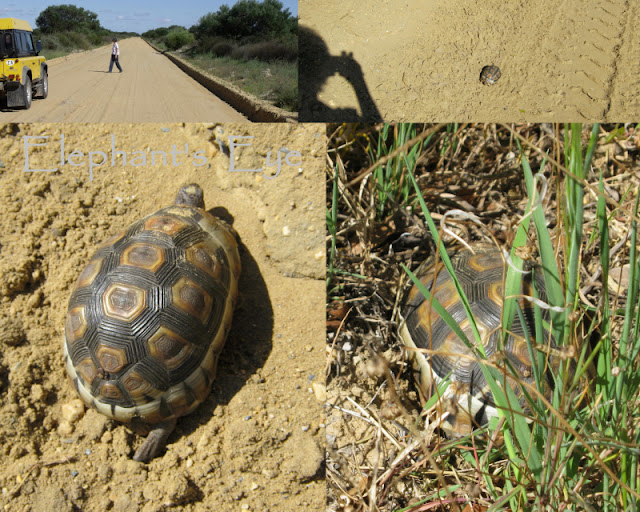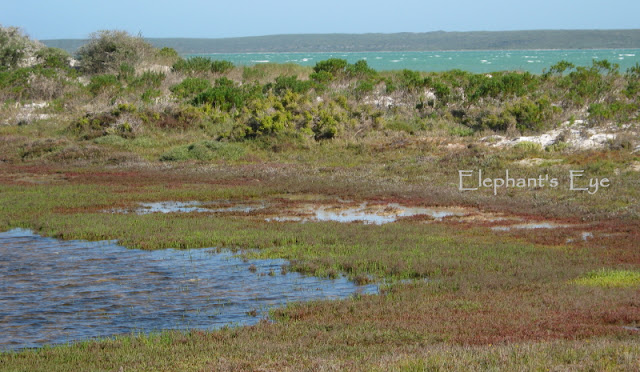Dung beetles to flamingoes in the West Coast National Park
By Diana Studer
- gardening for biodiversity
in Cape Town, South Africa
The years slip busily by. In 2010 we went to the West Coast National Park on
a hiking trail thru the spring
flowers. 2014 before we did return
to the flowers!
In 2010 an 'exotic' Ferraria iris was in our photo flower haul.
In 2010 an 'exotic' Ferraria iris was in our photo flower haul.
When we tried to cross the Berg River in 2007 this whole swathe was under water. Good for both employment and the environment that they are working at removing invasive alien trees.
We stop for tortoises. The recently graded sandy road left a
sharp sheer wall, trapping tortoises. We rescued two. With traffic flying
along, the tortoise’s defence is to duck down and pray for travelling mercies.
Almost perfect, except for a small damp patch at the snake's
head … where someone had stamped on it. A rhombic egg eater. Harmless to
people. They eat bird's eggs, which they swallow whole. Toothless
and defenceless, they will hiss and 'strike'.
Within the National Park we saw less road kill. The fat
stripy one is a puff adder Bitis arietans, with the Ungardener’s
hip so you can see how close we were. Being heavy-bodied and sluggish it relies
on immobility and cryptic camouflage. Another reason why we are warned to LOOK,
before stepping over a rock or fallen log. They will hiss in warning. This
common snake, basking in the sun – is the cause of most serious snake bites in
Africa. That bite is not fatal, but nasty.
The slender elegant one is a Cape cobra Naja nivea (with
a hood). Usually nocturnal so we were glad to see it. This one is dangerous;
you need prompt treatment if bitten. The prey of the mongoose. And the snake in
turn hunts gerbils and three striped mice. While we walked along, we saw a mole
snake Pseudapsis cana. A powerful constrictor, which will hiss and
bite if cornered. Because it is useful to farmers, it was one of the first
snakes to be protected in the Cape.
We walked down the sandy path, thru dense vegetation to one
of the bird hides. Remember the dung beetles at Addo?
Here we could get a better picture, since we were not leaning out of the car
window, dodging elephants!
The West Coast Park is on the Langebaan lagoon.
Salt marsh, sand dune, lagoon, sand bar. Postberg peninsula
and the Atlantic Ocean in the distance. Postberg is military land, but it is
open in August and September for the flowers. This quieter section we had
almost to ourselves.
On the sand bar, one good tern deserves another. A pair of
Caspian terns sits a little apart from the other birds. In the breeding season
he wears a black cap. The largest of the terns has a red beak. Despite the
name, they are resident on our coast.
He captured the flamingoes, just as a flock of gulls flew
past. Probably Greater flamingoes, since the wings were scarlet, when they in
turn flew.
 |
| Greater flamingoes |
Pictures by Diana and Jurg Studer
of Elephant's Eye on False Bay
(If you mouse over teal blue text, it turns seaweed red
Those are my links.
To read or leave comments, either click the word Comments below,
or click this post's title)










I enjoyed my visit here so much,, what an amazing adventure!
ReplyDeleteI am so glad you helped the tortoise up and on their way, I thought the first snake look strange ,, I had a feeling he was dead before I read it, poor thing,, are they hated because they eat eggs?
The adders are beautiful aren't they, such a distinct pattern, so fat,
the cobra always looks so elegant to me,
I suppose the constrictors eat rodents thats why the farmers like them, I understand that,,
the marshlands are beautiful ,, thanks for sharing this with us today,
Sadly for any snake - it's knee jerk reaction of Snake KILL it!
DeleteWe don't have a lawn, but still it was alarming to see quite how big the molehills are, that sprang up on our neighbour's lawn. Overnight 4 or 5 heaps each about a barrowload of sand, dumped on the lawn.
Got your new address. Enjoying the sights. Thanks.
ReplyDeleteit's good to see familiar bloggers again, you and thru you, Faire Garden.
DeleteOh my goodness Diana, to see all of those creature in the wild...especially the flamingoes....what a unbelievable sight.
ReplyDeleteWell, I could do without seeing the snakes in person, but other then that it would be amazing.
Jen
I promise! All the snakes were Not At Home to Visitors and withdrew as we intruded.
DeletePlease stay on the path - also protects seedlings.
What a fascinating place! I've always thought it would be fun to see one of those dung beetles in person. I've seen nature shows where they explain what they do, but how interesting to see them up close.
ReplyDeleteLovely pictures and post; interesting to see the snakes out already. I have seen people swerve to drive over them; that sort of action makes me sad.
ReplyDeletebeyond sad. Also the driven hunt in Limpopo fills me with despair.
DeleteI despair too sometimes over people with unthinking hostility to wildlife. We really are the most dangerous destructive species on earth. So many animals die from roadkill, I suppose like so many die from plastic in the sea. That national park looks wonderful. Great pic of the dung beetle.
ReplyDeleteDung beetles are pretty amazing, I saw one in the Karoo on my only visit (so far) to South Africa. Very tempted to go to Addo next time. The last pic with the flamingos and gulls is brilliant and, oh, the colour of that sea!
ReplyDeletehttp://eefalsebay.blogspot.co.za/2014/04/spekboom-at-Addo-Portulacaria-afra.html
Deleteand a few more posts
It's always a struggle to keep people on the paths. A few dangerous snakes might just do the trick. I am always thrilled to see snakes in our yard (once I get over the shock reaction to sudden movement slithering at my feet). So good to see sensitivity to invasive species increasing.
ReplyDeleteWhat beautiful places you have to visit in your part of the world! -Jean
ReplyDeleteAlways fascinating to see what's going on in your part of the world Diana. Dung beetles, not likely to come across them here, but we are keeping a look out for those dreaded Lily beetles. The most common roadkill in this part of the world was once hedgehogs, something we don't see these days, in fact I haven't seen a hedgehog for over ten years, sadly for whatever reason the numbers have declined drastically..
ReplyDeletethere's a caterpillar that preys on Agapanthus, which is changing local garden choices.
DeleteSomething rather endearing about hedgehogs, and dormice!
How I would love to take this trip, Diana -- the state park is so beautiful. I'm afraid of snakes but cannot condone the indiscriminate killing of them. Most of the snakes here are garden 'friends' providing a service by removing the bad guys, so we live and let live. P. x
ReplyDeletehmmm as the gardeners around us battle moles on their lawn, but would NOT appreciate seeing a mole snake in their garden.
DeleteThe mighty dung beetle reminds me of Hercules! This is a fascinating post. I always enjoy seeing the various types of wildlife in your part of the world. Such a beautiful place!
ReplyDeleteYour part of South Africa is stunningly beautiful. Italians have the same reaction to all snakes, I've seen harmless ones killed in front of me despite being vocal about the fact that they were harmless, I am always pleased to see them in the garden, although I haven't actually seen any this year, which is unusual, maybe there are just more places for them to hide now, which is good.
ReplyDeleteBeautiful Diana...I have always found dung beetles so fascinating....what a life rolling around a ball of dung. The marsh views are really breathtaking.
ReplyDeletebut, we work with compost and organic fertiliser when we garden ...
Deletegrow where you are planted ;~)